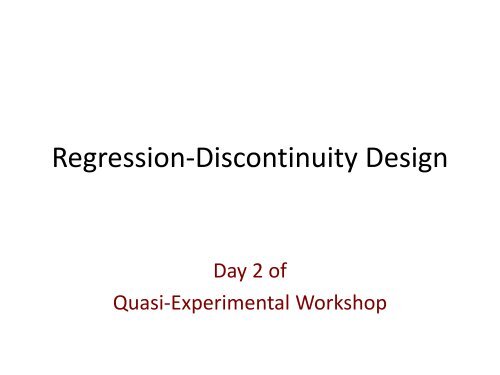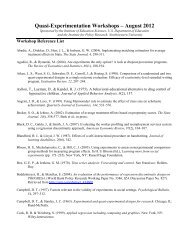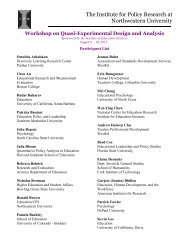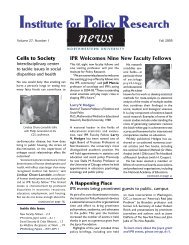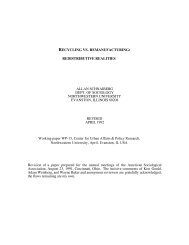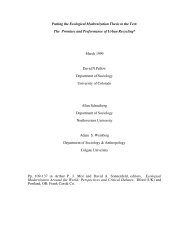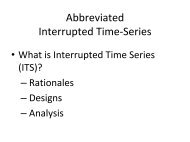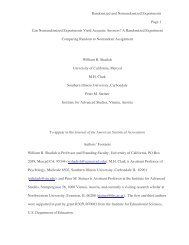Regression Discontinuity - Institute for Policy Research
Regression Discontinuity - Institute for Policy Research
Regression Discontinuity - Institute for Policy Research
Create successful ePaper yourself
Turn your PDF publications into a flip-book with our unique Google optimized e-Paper software.
<strong>Regression</strong>-<strong>Discontinuity</strong> Design<br />
Day 2 of<br />
Quasi-Experimental Workshop
Agenda<br />
• Design Overview<br />
• Estimation approaches<br />
• Addressing threats to validity<br />
• Example 1: Shadish, Galindo, Wong, V., Steiner, &<br />
Cook (2011)<br />
• Example 2: Wong, V., Cook, Barnett, & Jung (2008)<br />
• Improving RDD through the Use of Comparison<br />
Functions
Design Overview<br />
Design<br />
Examples<br />
Visual depiction<br />
Rationales
<strong>Regression</strong> <strong>Discontinuity</strong><br />
Resource allocation can be by a merit score, need (or<br />
risk) score, first come…, date of birth<br />
How prevalent are allocation mechanisms like this in a<br />
given society? Could they be even more prevalent?<br />
Two examples: Reading First and Head Start<br />
RD is the design <strong>for</strong> such circumstances<br />
Need to learn the language of RD that invokes an<br />
assignment variable, a cutoff defining treatment, and<br />
an outcome
RDD Visual Depiction<br />
Comparison
RDD Visual Depiction<br />
Comparison<br />
Treatment
RDD Visual Depiction<br />
<strong>Discontinuity</strong>, or treatment effect<br />
Counterfactual regression line<br />
Comparison<br />
Treatment
Two Rationales <strong>for</strong> RDD<br />
1. Selection process is completely known and can be<br />
modeled through a regression line of the<br />
assignment and outcome variables<br />
– Untreated portion of the AV serves as a<br />
counterfactual<br />
2. It is like an experiment around the cutoff<br />
– Benefit: Functional <strong>for</strong>m need not be identified
Two Rationales <strong>for</strong> RDD<br />
1. Selection process is completely known and can be<br />
modeled through a regression line of the<br />
assignment and outcome variables<br />
– Untreated portion of the AV serves as a<br />
counterfactual<br />
2. It is like an experiment around the cutoff<br />
– Benefit: Functional <strong>for</strong>m need not be identified<br />
away from the cutoff
Two Rationales <strong>for</strong> RDD<br />
1. Selection process is completely known and can be modeled<br />
through a regression line of the assignment and outcome<br />
variables<br />
– Untreated portion of the AV serves as a counterfactual<br />
2. It is like an experiment around the cutoff<br />
– Benefit: Functional <strong>for</strong>m need not be identified away<br />
from the cutoff<br />
• Empirically validated by 6 within-study comparisons<br />
(Aiken et al., 1998; Buddelmeyer & Skoufias, 2005;<br />
Black, Galdo & Smith, 2007; Berk et al., in press;<br />
Greene, 2010; Shadish et al., 2011), even though<br />
estimands differ between RE and RD and power too
Required Assumptions <strong>for</strong> RD design<br />
1. Prob. of treatment receipt must be<br />
discontinuous at cutoff. More of those<br />
receiving treatment should be on treatment<br />
side of cutoff than the other side. If all are,<br />
then “sharp” RD. Otherwise, “fuzzy” RD<br />
2. No discontinuity in potential outcomes in the<br />
cutoff (the “continuity restriction”). That is,<br />
no alternative interpretation should also<br />
show a discontinuity at the cutoff. If so, it<br />
would serve as a causal confound.
1. Overrides to the cutoff:<br />
Sharp, Fuzzy, and “Non-RD” Designs
Sharp RD Designs<br />
• Requires that the probability of treatment<br />
changes discontinuously from 1 to 0 at the<br />
cutoff such that limE[D i<br />
| z i<br />
= z c<br />
]-limE[D i<br />
| z i<br />
= z c<br />
]<br />
z¯zc zzc<br />
=1.<br />
• In practice, this means there are no<br />
cross-overs and no no-shows in the study.<br />
• Parametric, non-parametric, and semiparametric<br />
approaches may be applied <strong>for</strong><br />
estimating treatment effects.<br />
• Treatment effects are identified at the cutoff.
Fuzzy RD Designs<br />
• Requires a discontinuity in the probability of<br />
treatment at the cutoff such that<br />
limE[D i<br />
| z i<br />
= z c<br />
] ¹ limE[D i<br />
| z i<br />
= z c<br />
]<br />
z¯zc zzc<br />
, but not a 1 to 0 change.<br />
• In practice, this means some individuals<br />
“crossed-over” treatments or did not “show-up”<br />
<strong>for</strong> treatment.<br />
• Hahn, Todd, and van der Klaauw (2001) show<br />
that when fuzziness occurs, the local average<br />
treatment effect (LATE) may be inferred <strong>for</strong> the<br />
subset of individuals who are induced into<br />
treatment at the cutoff.
Estimating Treatment Effects in<br />
Fuzzy RDDs<br />
• LATE is equivalent to the difference in mean<br />
outcomes <strong>for</strong> the treatment and comparison<br />
groups (ITT estimate) divided by the difference in<br />
treatment receipt rates <strong>for</strong> both groups within a<br />
close neighborhood around the cutoff.<br />
lim<br />
z¯z c<br />
lim<br />
z¯z c<br />
E[Y i<br />
| z i<br />
= z c<br />
]- limE[Y i<br />
| z i<br />
- z c<br />
]<br />
zz c<br />
E[D i<br />
| z i<br />
= z c<br />
]- limE[D i<br />
| z i<br />
- z c<br />
]<br />
zz c<br />
• In a regression framework, this is estimated<br />
through a two-stage least square IV approach.
Requirements <strong>for</strong> Estimating<br />
Treatment Effects in Fuzzy RDDs<br />
• Similar to how non-compliance is handled in<br />
randomized experiments<br />
• Requires the following:<br />
1. That the instrument (treatment assignment) is<br />
correlated with treatment receipt; and<br />
2. That the instrument is not correlated with errors<br />
in the outcome model.
“Non”-RD designs<br />
• No discontinuity in the probability of<br />
treatment at the cutoff.<br />
• Occurs when there are so many overrides to<br />
the cutoff that the assignment mechanism is<br />
meaningless.<br />
• Treatment effects cannot be estimated at the<br />
cutoff.
Implementation Threats to RD Design<br />
1. Overrides to the cutoff<br />
a. Sharp design<br />
b. Fuzzy design<br />
c. Extreme “fuzziness” with no discontinuity in<br />
probability of treat at cutoff<br />
2. Manipulation of assignment scores by units
2. Manipulation of the<br />
assignment variable<br />
• Occurs when participants manipulate assignment<br />
scores to receive or avoid treatment.<br />
• Different from “overrides to the cutoff” because<br />
researcher does not know what scores – and<br />
treatment assignment – participants should have<br />
received.<br />
• No definitive test <strong>for</strong> knowing when it occurs, but<br />
graphical analysis can help detect when it does.
Example: AYP Data from Texas<br />
0 .01 .02 .03 .04<br />
Density<br />
Histogram<br />
Kernel Density Plot<br />
0 10 20 30<br />
0 20 40 60 80<br />
Math proficiency score<br />
Drop in density of<br />
observations be<strong>for</strong>e cutoff<br />
-.6 -.4 -.2 0 .2 .4<br />
z<br />
Treatment kernel density plot<br />
Comparison kernel density plot<br />
Jump in density of observations<br />
at the cutoff
Diagnostic test<br />
• Can per<strong>for</strong>m “McCrary Test” (2008)<br />
– Basically a statistical test <strong>for</strong> assessing whether<br />
there is a discontinuity in the density of<br />
observations at the cutoff.<br />
– Test is “reassuring” <strong>for</strong> the analyst, but not<br />
sufficient <strong>for</strong> proving the validity of the design.<br />
– Must combine thoughtful consideration of the<br />
assignment process with observation of<br />
distribution of data around the cutoff.
What to do?<br />
• This is a big problem, because there is no work<br />
(we are aware of) <strong>for</strong> addressing manipulation<br />
of assignment process when it occurs.<br />
• Can – and should -- examine qualitatively how<br />
manipulation of assignment scores occurred<br />
and control <strong>for</strong> those cases
Analytic Threats to RD Design: Parametric<br />
Analyses<br />
1. Misspecification of the response function
Analytic Threats to RD Design: Misspecification<br />
of functional <strong>for</strong>m in Parametric Analyses<br />
• Recall, in RDD, we measure the size of the<br />
effect as the size of the discontinuity in<br />
regression lines at the cutoff:
The size of the discontinuity at the cutoff is the size of the effect.
Nonlinearities in Functional Form<br />
• Anything that affects the size of that discontinuity<br />
other than treatment is a threat.<br />
• In the example, we assumed the relationship<br />
between assignment and outcome was linear—<br />
regressions are straight lines.<br />
• But functional <strong>for</strong>m can be nonlinear due to:<br />
– Nonlinear Relationships between the assignment<br />
variable and the outcome<br />
– Interactions between the assignment variable and<br />
treatment.
Functional Form<br />
• Put more technically, effects are unbiased only if the<br />
functional <strong>for</strong>m of the relationship between the<br />
assignment variable and the outcome variable is<br />
correctly modeled<br />
• Consider first the example of a nonlinear relationship<br />
between the assignment variable and the outcome<br />
variable:
If we super-impose a nonlinear regression line 1 onto the data, a line that seems to<br />
match the curves in the data pretty well, we see no discontinuity at the cutoff<br />
anymore, and correctly conclude that the treatment had no effect.<br />
1<br />
In this case, a cubic function (X 3 )
Functional Form: Interactions<br />
• Sometimes the treatment works better <strong>for</strong> some<br />
people than <strong>for</strong> others<br />
– For example, it is common to find that more advantaged<br />
children (higher SES, higher pretest achievement scores)<br />
benefit more from treatment than do less advantaged<br />
children.<br />
• If this interaction (between the assignment variable<br />
and treatment) is not modeled correctly, a false<br />
discontinuity will appear:
Here we see a discontinuity that suggests a treatment effect. However, these data are<br />
again modeled incorrectly, with a linear model that contains no interaction terms,<br />
producing an artifactual discontinuity at the cutoff…
If we superimpose the regression lines that would have been obtained had an<br />
interaction term been included, we would find no discontinuity at the cutoff…
The interpretation of this example is important to understand. The title of the graph<br />
says “false treatment main effect”. However, the treatment did have an interaction<br />
effect: Treatment helped children with higher scores on the assignment variable more<br />
than children with lower scores on the assignment variable…
Here we see an example where the treatment had both a main effect and an<br />
interaction effect, correctly modeled.<br />
main<br />
^
How to Detect Nonlinearities<br />
• Visual Inspection of relationship between assignment<br />
and outcome prior to treatment (e.g., if archival data<br />
is used).<br />
• Visual Inspection of the Graph<br />
• Computer Programs (e.g, Cook and Weisberg)<br />
• Analysis: Overfitting the model (more on this later).
Adding Nonlinear Terms to the Model<br />
• Include nonlinear functions of the assignment<br />
variable in the equation, <strong>for</strong> example:<br />
Y i<br />
= ˆb 0<br />
+ ˆb 1<br />
d + ˆb 2<br />
(z i<br />
- z c<br />
) + ˆb 3<br />
(z i<br />
- z c<br />
) 2 + e i<br />
Where d is the treatment indicator and z is the assignment variable<br />
• There are many such nonlinear functions, so<br />
selecting the correct one is crucial
Adding Interaction Terms to the Model<br />
• One can also add interactions between treatment<br />
assignment (d) and the assignment variable (z), <strong>for</strong><br />
example:
Adding Nonlinear and Interaction Terms<br />
to the Model<br />
• And one can add both nonlinear and interaction<br />
terms to the model:<br />
Y i<br />
= ˆb 0<br />
+ ˆb 1<br />
d i<br />
+ ˆb 2<br />
(z i<br />
- z c<br />
) + ˆb 3<br />
(z i<br />
- z c<br />
) 2<br />
+ ˆb 4<br />
d i<br />
(z i<br />
- z c<br />
) + ˆb 5<br />
d i<br />
(z i<br />
- z c<br />
) 2 + e i<br />
• As you can imagine, the model can get quite large.<br />
• Though it may seem complex, all this can easily be<br />
done in SPSS, and all the relevant terms can easily be<br />
defined with simple SPSS Compute statements.
How Do You Know Which Terms to Add?<br />
• If you did a pretest run of the design (be<strong>for</strong>e<br />
treatment was begun), use that data to model the<br />
baseline functional <strong>for</strong>m.<br />
• Visually inspect the data <strong>for</strong> clues about what <strong>for</strong>m<br />
seems likely.<br />
• Use available programs <strong>for</strong> curve fitting in order to<br />
explore possible functional <strong>for</strong>ms (e.g., Cook &<br />
Weisberg, 1994)
Adding Terms, Continued<br />
• When in doubt, start by overfitting the model:<br />
– Add more polynomial and interaction terms than you think<br />
are needed, and then eliminate the nonsignificant ones<br />
(from higher order to lower order).<br />
– When in doubt, keep terms in the equation; such<br />
overfitting will yield unbiased estimates, but will reduce<br />
power the more nonsignificant terms are kept.
Adding Terms, Continued<br />
• Sensitivity Analyses: Do substantive conclusions vary<br />
with different assumptions about which terms to<br />
add?<br />
• If sample size is large, split the sample in half<br />
randomly:<br />
– Develop the model on one half<br />
– Cross-validate the model on the other half.
Example of Parametric Plot used again later<br />
RD data from Shadish, Galindo, Wong, V., Steiner, & Cook (2011)<br />
Comparison<br />
Treatment
But Parametric Analyses being Replaced by Non-<br />
Parametric and Semi-Parametric ones
Non-parametric Approach<br />
lim<br />
x¯c<br />
E[Y i<br />
| z i<br />
= z c<br />
]-lim<br />
xc<br />
E[Y i<br />
| z i<br />
= z c<br />
]<br />
• Where z i is the assignment score, z c is the<br />
cutoff, and Y i are the outcomes.<br />
• Treatment effects estimated by examining the size<br />
of the discontinuity in the conditional expectation of<br />
the outcome given the assignment variable <strong>for</strong><br />
observations at the cutoff.<br />
• The limits are often estimated by non-parametric<br />
local linear kernel regression –need to explain this.<br />
• Allows analyst to relax assumptions about functional<br />
<strong>for</strong>m away from the cutoff.
Non-parametric plot<br />
Local linear kernel regression in STATA<br />
RD data from Shadish, Galindo, Wong, V., Steiner, & Cook (2011)<br />
Comparison<br />
Treatment
3. Semi-Parametric Approach<br />
Y<br />
i<br />
= t D + f ( Z ) + X ã + e<br />
i<br />
• Where Y i , D i , and X i are the same as be<strong>for</strong>e, and f(Z i ) in the<br />
generalized additive model is the smooth function of the<br />
assignment variable <strong>for</strong> the control and treatment groups.<br />
• The smooth function is typically modeled using a series of<br />
splines.<br />
• Treatment effect ( ) may be estimated via thin plate regression<br />
splines using the mcgv-package in R (R Development Core<br />
Team, 2009; Wood, 2006).<br />
• Advantage is that it allows <strong>for</strong> flexibility in modeling the<br />
response function while controlling <strong>for</strong> baseline covariates in<br />
the model.<br />
i<br />
t<br />
i<br />
i
Vocabulary Outcome<br />
10 15 20<br />
Semi-Parametric Plot<br />
RD data from Shadish, Galindo, Wong, V., Steiner, & Cook (2011)
Problem of Incorrect Bandwidth Selection<br />
Bias versus efficiency tradeoff
What to do?<br />
• Check to see whether treatment effects are robust to<br />
alternative specifications of bandwidth<br />
• State of art is to use Imbens & Kalyanaraman (2010) (IK)<br />
optimal bandwidth module that takes account of<br />
boundary issues<br />
– IK programs <strong>for</strong> bandwidth selection <strong>for</strong> Stata and Matlab:<br />
http://www.economics.harvard.edu/faculty/imbens/software_imb<br />
ens<br />
- IK Program <strong>for</strong> bandwidth selection in R<br />
http://web.me.com/devin.caughey/Site/Code.html
RDD Example 1
Shadish, Galindo, Wong, V., Steiner, & Cook<br />
(2011)<br />
Vocabulary intervention<br />
• Example of how we probed all required assumptions<br />
in our analysis of an RDD<br />
• Assignment was based on a pretest score on a<br />
vocabulary exam.<br />
• Students who scored below the cutoff (20) received<br />
online vocabulary training, those who scored above<br />
the cutoff received a math training.<br />
• Sample was a pool of students at UC Merced who<br />
agreed to participate in an online study.
RD Design assumption 1<br />
• Probability of treatment discontinuous at cutoff
Implementation threat 1<br />
• Overrides to the cutoff (misallocation of treatment)<br />
– Examined whether participants entered appropriate<br />
assigned treatment conditions by looking at assignment<br />
scores, the cutoff, and treatment receipt status.<br />
– No evidence of individual changing treatment status based<br />
on what they were assigned.<br />
– 0% cross-over; 0% no-shows
Implementation assumption 2<br />
• No evidence of manipulation of the assignment<br />
variable
Analytic assumption 1<br />
• Correct specification of functional <strong>for</strong>m <strong>for</strong><br />
parametric analyses<br />
Linear function
Analytic assumption 1 continued<br />
• Correct specification of functional <strong>for</strong>m <strong>for</strong><br />
parametric analyses<br />
Cubic function
What to do?<br />
• Conduct graphical analyses<br />
• Examine residuals<br />
• Check to see whether treatment effects are robust to<br />
alternative specifications of functional <strong>for</strong>m<br />
• Check to see whether treatment effects are robust to<br />
alternative pseudo-cutoffs<br />
• Estimate treatment effects using non-parametric and<br />
semi-parametric approaches
Shadish et al. (2011)<br />
Vocabulary<br />
RDD<br />
mean (s.e.)<br />
(1) Linear regression 5.05 (0.57)***<br />
(2) Quadratic regression* 5.91 (0.77)***<br />
(3) Cubic regression 6.04 (1.07)***<br />
(4) Generalized additive Model (GAM) 5.76 (0.72)***<br />
(5) Local linear regression 6.28 (1.12)***<br />
*The quadratic function was selected as the optimal RDD model
Analytic assumption 2<br />
• Correct specification of bandwidth <strong>for</strong> non-parametric estimates<br />
– Used Imbens & Kalyanaraman (2010) algorithm <strong>for</strong> choosing optimal<br />
bandwidth<br />
– Estimated treatment effects using bandwidths that were ½ and double the<br />
size of the IK optimal bandwidth to check robustness of estimates.<br />
Optimal BW: Treatment effect <strong>for</strong> Non-parametric (4): 6.48<br />
TR est: 13.21 / CI <strong>for</strong> TR: 10.94 - 15.48<br />
CO est: 6.73 / CI <strong>for</strong> CO: 5.92 - 7.55<br />
½ Optimal BW: Treatment effect <strong>for</strong> Non-parametric (2): 5.1<br />
TR est: 12 / CI <strong>for</strong> TR: 10.75 - 13.25<br />
CO est: 6.9 / CI <strong>for</strong> CO: 5.93 - 7.87<br />
Double optimal BW: Treatment effect <strong>for</strong> Non-parametric (8): 5.89<br />
TR est: 12.27 / CI <strong>for</strong> TR: 10.86 - 13.69<br />
CO est: 6.39 / CI <strong>for</strong> CO: 5.74 - 7.04
RDD Example 2
Wong, V., Cook, Barnett, & Jung (2008)<br />
State Pre-Kindergarten Example<br />
• In this example, we were particularly concerned<br />
about 3 issues: (1) functional <strong>for</strong>m assumptions; (2)<br />
overrides to the cutoff and (3) design limitations:<br />
• Study Design<br />
– Pre-K available by birth date cutoff in 38 states, here scaled<br />
as 0 (zero)<br />
– 5 chosen <strong>for</strong> study and summed here<br />
– How does pre-K affect PPVT (vocabulary) and print<br />
awareness (pre-reading)
Best case scenario – regression line is linear and parallel<br />
(NJ Math)<br />
0 10 20 30<br />
Applied Math<br />
1. Mis-specification of Functional Form<br />
(Pre-K Example)<br />
-400 -200 0 200 400<br />
Days from cutoff<br />
woodcock-johnson raw score<br />
Fitted values<br />
woodcock-johnson raw score<br />
Fitted values
Sometimes, <strong>for</strong>m is less clear<br />
Example: Oklahoma Print Awareness<br />
0 10 20 30 40<br />
0 10 20 30 40<br />
Print awareness<br />
Print awareness<br />
Mis-specification of Functional Form<br />
(Pre-K Example)<br />
-400 -200 0 200 400<br />
Days from cutoff<br />
print awareness raw score<br />
Fitted values<br />
Linear plot<br />
print awareness raw score<br />
Fitted values<br />
-400 -200 0 200 400<br />
Days from cutoff<br />
print awareness raw score<br />
lowess paraw cutmarg<br />
Lowess plot<br />
print awareness raw score<br />
lowess paraw cutmarg
Correct specification of functional <strong>for</strong>m assumption<br />
What to do about functional <strong>for</strong>m (1)<br />
• Graphical approaches
Graphical analysis (New Jersey PPVT)<br />
0 50 100 150<br />
0 50 100 150<br />
PPVT<br />
locpoly smooth: rawscor<br />
-400 -200 0 200 400<br />
Days from cutoff<br />
ppvt/tvip raw score<br />
lowess rawscor cutmarg<br />
ppvt/tvip raw score<br />
lowess rawscor cutmarg<br />
-400 -200 0 200 400<br />
cutmarg<br />
locpoly smooth: rawscor<br />
locpoly smooth: rawscor<br />
0 50 100 150<br />
PPVT<br />
Lowess<br />
Local Linear <strong>Regression</strong><br />
(LLN)<br />
<strong>Regression</strong><br />
-400 -200 0 200 400<br />
Days from cutoff<br />
ppvt/tvip raw score<br />
Fitted values<br />
ppvt/tvip raw score<br />
Fitted values
What to do (2)<br />
• Parametric approaches<br />
– Alternate specifications and samples<br />
• Include interactions and higher order terms<br />
– Linear, quadratic, & cubic models<br />
– Look <strong>for</strong> statistical significance <strong>for</strong> higher order terms<br />
– When functional <strong>for</strong>m is ambiguous, overfit the model (Sween 1971;<br />
Trochim 1980)<br />
• Truncate sample to observations closer to cutoff<br />
– Bias versus efficiency tradeoff
What to do (3)<br />
• Non-parametric approaches<br />
– What are non-parametric approaches?<br />
• Eliminates functional <strong>for</strong>m assumptions<br />
• Per<strong>for</strong>ms a series of regressions within an interval, weighing<br />
observations closer to the boundary<br />
• Use local linear regression because it per<strong>for</strong>ms better at the<br />
boundaries<br />
– What depends on selecting correct bandwidth?<br />
• Key tradeoff in NP estimates: bias vs precision<br />
– How do you select appropriate bandwidth?<br />
– Ocular/sensitivity tests<br />
– Imbens & Kalyanaraman (2010)<br />
– Cross-validation methods<br />
» “Leave-one-out” method
What to do (4)<br />
0 50 100 150<br />
locpoly smooth: rawscor<br />
• State-of-art is imperfect<br />
• So we test <strong>for</strong> robustness<br />
and present multiple estimates<br />
-400 -200 0 200 400<br />
cutmarg<br />
locpoly smooth: rawscor<br />
locpoly smooth: rawscor<br />
NJ PPVT LLR Plot<br />
New Jersey<br />
PPVT<br />
Parametric estimates<br />
Non-Parametric<br />
estimates<br />
Linear Quadratic Cubic 6 months 30 BW 40 BW<br />
(1) (2) (3) (4) (5) (6)<br />
5.71* 5.37* 5.26 4.98* 8.09* 7.96*<br />
(1.44) (2.02) (2.72) (1.93) (3.86) (2.64)
locpoly smooth: wjraw<br />
10 12 14 16 18<br />
What to do (4)<br />
• Another example<br />
• Where function appears<br />
to be cubic<br />
-400 -200 0 200 400<br />
cutmarg<br />
locpoly smooth: wjraw<br />
OK Plot<br />
locpoly smooth: wjraw<br />
Parametric estimates<br />
Non-Parametric<br />
estimates<br />
Linear Quadratic Cubic 6 months 40 BW<br />
Oklahoma<br />
Print<br />
Awareness<br />
21.01* 15.55* 9.25 .465 4.78<br />
(3.52) (4.84) (6.91) (9.70) (9.91)
What to do (5)<br />
• Move to a tie breaker experiment, with both RD and<br />
random assignment around cutoff
Tie-breaking experiment design
Example<br />
Cocaine Project<br />
• Included 500 patients addicted to cocaine<br />
• Purpose was to show whether intensive in-patient<br />
rehabilitation showed better improvement <strong>for</strong> patients as<br />
opposed to outpatient care<br />
• Assignment variable was a composite score based on the<br />
following: 1) employment and legal status; 2) family<br />
relationship and recovery; 3) alcohol and drug history; 4)<br />
psychological status..<br />
• Patients with scores above 60 assigned to inpatient rehab;<br />
patients with scores less than 40 assigned outpatient<br />
rehab; those with scores 40-60 in randomized trial.<br />
• Used RD-RE design b/c randomized experiment was<br />
consider neither ethical nor feasible.
Post-test values<br />
What to do (6)<br />
• Curtail at the tails and use cases to sample as<br />
densely as possible around the cutoff<br />
x<br />
o<br />
o o<br />
o o<br />
o<br />
o o<br />
o o<br />
o<br />
o<br />
o o o<br />
o<br />
o o o o<br />
o<br />
o<br />
x<br />
x x x<br />
x<br />
x<br />
x x<br />
x x x<br />
x<br />
x<br />
x<br />
x<br />
x<br />
x<br />
x<br />
x<br />
Assignment Variable
What to do (7)<br />
• Estimation through design<br />
– Cohort Comparison: becomes an almost independent estimate of the<br />
counterfactual functional <strong>for</strong>m of the missing treatment group<br />
– Other design RDD features: pretests, nonequivalent dependent<br />
variable
Summary concerning mis-specification of the<br />
response function<br />
• Do Graphical analyses<br />
• In parametric models, do alternative specifications<br />
• Also do non-parametric estimates<br />
• Present multiple estimates to check robustness<br />
• If possible, move to tie-breaker experiment around<br />
the cutoff<br />
• If possible, sample densely at the cutoff<br />
• If possible, use pretest or other comparison RD<br />
functions
2. Dealing with Overrides to the cutoff<br />
• Observe misallocation in the data<br />
States<br />
Fuzzy cases<br />
Michigan 2%<br />
New Jersey 4%<br />
Oklahoma 4%<br />
South Carolina 1%<br />
West Virginia 8%
What to do about fuzzy allocation?<br />
• RDD as an instrumental variable<br />
– Provides causal estimates if instrument is correlated with treatment<br />
and not with errors in the outcome.<br />
– Proof: Hahn, Todd, and van der Klaauw, 2001<br />
– Examples: Angrist & Lavy, 1999; Jacob and Lefgren, 2004a, 2004b;<br />
van der Klaauw, 2002<br />
– In this case, we implemented in a regression (two stage least<br />
squares) framework as opposed to the non-parametric wald<br />
estimator
2. Overrides to the cutoff<br />
• Multiple estimations<br />
Michigan<br />
PPVT<br />
Full sample<br />
Restricted<br />
sample<br />
Instrumental<br />
Variable<br />
% Fuzzy (8) (9) (11)<br />
2% -2.20 -1.91 -2.75<br />
(3.64) (4.15) (4.53)<br />
West Virginia 8% 2.75 3.66 2.42<br />
PPVT (2.23) (2.39) (1.94)<br />
Michigan 2% 25.21* 24.98* 22.14*<br />
Print<br />
Awareness<br />
(3.48) (3.58) (3.11)<br />
West Virginia 8% 22.25* 24.49* 20.15*<br />
Print<br />
Awareness<br />
(3.59) (3.50) (2.98)
Summary of Analytic Plan <strong>for</strong> Addressing<br />
Mis-specification of the Functional Form and Overrides<br />
to the Cutoff in the Pre-K data
Specification of Functional Form<br />
Parametric approaches (1)<br />
Function<br />
al <strong>for</strong>m<br />
Parametric models in<br />
analyses<br />
Linear Quad Cubic<br />
(1) (2) (3) (4)<br />
PPVT Quad 0.33 -1.91 -3.18<br />
(2.49) (4.15) (5.62)<br />
Student<br />
covariates Yes Yes Yes<br />
Fuzzy<br />
cases No No No
Specification of Functional Form<br />
Parametric approaches (2)<br />
Function<br />
al <strong>for</strong>m<br />
Parametric models used in<br />
analysis<br />
Linear Quad Cubic<br />
6<br />
mnth<br />
s<br />
(1) (2) (3) (4) (5)<br />
PPVT Quad 0.33 -1.91 -3.18 -3.74<br />
(2.49) (4.15) (5.62) (6.10)<br />
Student<br />
covariates Yes Yes Yes Yes<br />
Fuzzy<br />
cases No No No No
Specification of Functional Form<br />
Non-parametric approaches<br />
Parametric models used in<br />
analysis<br />
Nonparametric<br />
estimates by<br />
bandwidth<br />
Function<br />
al <strong>for</strong>m<br />
Linear Quad Cubic<br />
6<br />
mnths<br />
50<br />
BW<br />
75<br />
BW<br />
(1) (2) (3) (4) (5) (6) (7)<br />
PPVT Quad 0.33 -1.91 -3.18 -3.74 -4.99 -1.66<br />
(2.49) (4.15) (5.62) (6.10) (4.40) (3.91)<br />
Student<br />
covariates Yes Yes Yes Yes No No<br />
Fuzzy<br />
cases No No No No No No
Overrides to cutoff (1)<br />
Alternative samples<br />
Function<br />
al <strong>for</strong>m<br />
Parametric models used in<br />
analysis<br />
Linear Quad Cubic<br />
6<br />
mnths<br />
Non-parametric<br />
estimates by<br />
bandwidth<br />
50<br />
BW<br />
75 BW<br />
OLS estimates<br />
Full<br />
(ITT)<br />
Restri<br />
cted<br />
(TOT)<br />
(1) (2) (3) (4) (5) (6) (7) (8) (9)<br />
PPVT Quad 0.33 -1.91 -3.18 -3.74 -4.99 -1.66 -2.20 -1.91<br />
(2.49) (4.15) (5.62) (6.10) (4.40) (3.91) (3.64) (4.15)<br />
Student<br />
covariates Yes Yes Yes Yes No No Yes Yes<br />
Fuzzy<br />
cases No No No No No No Yes No
Overrides to cutoff (2)<br />
Alternative samples (with and w/o covariates)<br />
Function<br />
al <strong>for</strong>m<br />
Parametric models used in<br />
analysis<br />
Linear Quad Cubic<br />
6<br />
mnths<br />
Non-parametric<br />
estimates by<br />
bandwidth<br />
50<br />
BW<br />
75 BW<br />
OLS estimates<br />
Full<br />
sampl<br />
e<br />
(ITT)<br />
Restri<br />
cted<br />
sampl<br />
e<br />
(TOT)<br />
IV estimates<br />
with and<br />
without<br />
covariates<br />
IV 1<br />
(TOT)<br />
IV 2<br />
(TOT)<br />
(1) (2) (3) (4) (5) (6) (7) (8) (9) (10) (11)<br />
PPVT Quad 0.33 -1.91 -3.18 -3.74 -4.99 -1.66 -2.20 -1.91 -1.51 -2.75<br />
(2.49) (4.15) (5.62) (6.10) (4.40) (3.91) (3.64) (4.15) (4.88) (4.53)<br />
Student<br />
covariates Yes Yes Yes Yes No No Yes Yes No Yes<br />
Fuzzy<br />
cases No No No No No No Yes No Yes Yes
All Outcomes<br />
Functiona<br />
l <strong>for</strong>m<br />
Parametric models used in analysis<br />
Linear Quad Cubic<br />
Non-parametric<br />
estimates by<br />
bandwidth<br />
6<br />
mnths 50 BW 75 BW<br />
OLS estimates<br />
Full<br />
sampl<br />
e (ITT)<br />
Restric<br />
ted<br />
sample<br />
(TOT)<br />
IV estimates<br />
with and without<br />
covariates<br />
IV 1<br />
(TOT)<br />
IV 2<br />
(TOT)<br />
(1) (2) (3) (4) (5) (6) (7) (8) (9) (10) (11)<br />
PPVT Quad 0.33 -1.91 -3.18 -3.74 -4.99 -1.66 -2.20 -1.91 -1.51 -2.75<br />
(2.49) (4.15) (5.62) (6.10) (4.40) (3.91) (3.64) (4.15) (4.88) (4.53)<br />
Math Linear 2.03* 2.25* 2.47 1.91* 2.99* 2.35* 2.07* 2.03* 1.87* 1.82*<br />
(0.56) (0.90) (1.29) (0.87) (0.86) (1.02) (0.55) (0.56) (0.51) (0.48)<br />
Print<br />
awareness Linear 24.98* 21.58* 21.75 21.79* 19.31* 22.19* 25.21* 24.98* 22.23* 22.14*<br />
(3.58) (5.68) (7.77) (5.58) (5.993) (5.155) (3.483) (3.578) (3.185) (3.105)<br />
Student<br />
covariates Yes Yes Yes Yes No No Yes Yes No Yes<br />
Fuzzy<br />
cases No No No No No No Yes No Yes Yes
Final estimates<br />
Function<br />
al <strong>for</strong>m<br />
Parametric models used in analysis<br />
Linear Quad Cubic<br />
Non-parametric<br />
estimates by<br />
bandwidth<br />
6<br />
mnths 50 BW 75 BW<br />
OLS estimates<br />
Full<br />
sample<br />
(ITT)<br />
Restricte<br />
d sample<br />
(TOT)<br />
IV estimates with<br />
and without<br />
covariates<br />
IV 1<br />
(TOT)<br />
IV 2 (TOT)<br />
(1) (2) (3) (4) (5) (6) (7) (8) (9) (10) (11)<br />
PPVT Quad 0.33 -1.91 -3.18 -3.74 -4.99 -1.66 -2.20 -1.91 -1.51 -2.75<br />
(2.49) (4.15) (5.62) (6.10) (4.40) (3.91) (3.64) (4.15) (4.88) (4.53)<br />
Math Linear 2.03* 2.25* 2.47 1.91* 2.99* 2.35* 2.07* 2.03* 1.87* 1.82*<br />
(0.56) (0.90) (1.29) (0.87) (0.86) (1.02) (0.55) (0.56) (0.51) (0.48)<br />
Print<br />
awareness Linear 24.98* 21.58* 21.75 21.79* 19.31* 22.19* 25.21* 24.98* 22.23* 22.14*<br />
(3.58) (5.68) (7.77) (5.58) (5.993) (5.155) (3.483) (3.578) (3.185) (3.105)<br />
Student<br />
covariates Yes Yes Yes Yes No No Yes Yes No Yes<br />
Fuzzy cases No No No No No No Yes No Yes Yes
Main Design Problem using<br />
Age-Related, but not other, Cutoffs<br />
Differential entrance and attrition time in TR and CO groups:<br />
- Treatment group consists of students who are in kindergarten in<br />
the fall<br />
–Control group consists of students who are enrolled in pre-K in the<br />
fall<br />
–Are there compositional differences between children who stay in<br />
pre-K until the fall of their kindergarten year (treatment group) and<br />
children who are just starting pre-K and so have not had a chance to<br />
attrit (control group)
Addressing Potential Issues with using<br />
Age-Related Cutoffs<br />
• Differential entrance and attrition time in TR and CO groups<br />
– Are there compositional differences between children who make it to the fall of<br />
their kindergarten year (treatment group) and children who are just starting<br />
pre-K (control group)<br />
• Particularly troubling concern because it could introduce serious bias<br />
in the design and make the approach invalid<br />
– Prompting some critics to ask, Is this an RD design at all?
Potential Issues with using<br />
Age-Related Cutoffs<br />
• The <strong>for</strong>egoing concerns suggest null hypotheses we could examine:<br />
– Since treatment children had opportunities to attrite that control children did<br />
not have, there should be more “missing” children in the treatment group.<br />
• Examine the data to determine whether there is a discontinuity in the<br />
DENSITY of observations at the cutoff.<br />
– Attrition could result in compositional differences between groups<br />
• Examine the data to determine whether there are discontinuities in third<br />
variables CONDITIONAL MEANS at the cutoff<br />
• Both of these concern possible violations to the RD assumption of no<br />
discontinuities in the potential outcomes (called Assumption 2)<br />
• Begin with conditional means on 3 rd variables
African-American<br />
Home language Spanish<br />
Girl<br />
Free/Reduced lunch
Fallible RD?<br />
• Looked <strong>for</strong> discontinuities in control variables and saw:<br />
– No significant differences in any of our control covariates<br />
at the cutoff (within states and across states)<br />
– But we had access to only a few demographic covariates<br />
(gender, race/ethnicity, free/reduced price lunch, child’s<br />
home language)
What about cutoff Shift in Number<br />
of Children?<br />
• Now we look <strong>for</strong> discontinuities in the density<br />
of observations (McCrary test)<br />
– The McCrary test can help us probe whether there<br />
was unobserved selection
McCrary Test <strong>for</strong> All States
McCrary Test <strong>for</strong> New Jersey
Fallible RD?<br />
• When we probed the New Jersey data, we found that the<br />
discontinuity in the McCrary test was driven by cases with a<br />
September 1 st cutoff.<br />
• Five years ago, children who were born on September 1 st<br />
were born on a Monday and children who were born on<br />
August 31 st , were born on Sunday.<br />
• Birth record data shows that there are large “day” effects<br />
(i.e. more births on Fridays and Mondays, fewer births on<br />
weekends and holidays), so the discontinuity may be driven<br />
by day effects<br />
• Not a problem if the “day effects” are not correlated with<br />
students’ achievement, but still under investigation.<br />
• Not a problem in 4 other states.
Take Home Message<br />
• Like RE, the RD design must be implemented<br />
carefully – with careful consideration of all<br />
possible selection effects and violations to the<br />
assignment mechanism.<br />
• Use state-of-the-art methods <strong>for</strong> probing the<br />
validity of the RD (such as checking whether<br />
there are discontinuities in third variables and in<br />
the density of observations).<br />
• But even these implementation tests require<br />
careful consideration of the data (i.e. “day<br />
effects”).
Other Kinds of Threats with RD<br />
1. Lower statistical power than the experiment<br />
2. Treatment effects estimated from an RDD may have<br />
less generalization than treatment effects estimated<br />
from a randomized experiment
Inadequate statistical power<br />
• Need adequate power <strong>for</strong> estimating regression<br />
line on both sides of the cutoff.<br />
– Randomized experiments more efficent than RDD by a<br />
factor of about 2.73 (Goldberger, 1972b)
Variance of Impact Estimator in RA<br />
^<br />
Var ra (α 0 ) = σ 2 (1-R ra2 )<br />
np(1-p)(1-ns-co) 2<br />
• σ 2 is the variance of mean student outcomes across schools<br />
within the treatment or comparison group<br />
• R ra<br />
2<br />
is the square of the correlation between school<br />
outcomes and the assignment variable<br />
• np(1-p) is the total variation in treatment status across<br />
schools<br />
• ns is the no-show (via appeals) rate<br />
• co is the cross-over (via participation) rate
Power Considerations Common to Randomized<br />
Experiments and RDD<br />
1. Sample size -- increase N<br />
2. Distribution of outcome variable - normal if<br />
possible<br />
3. Misallocation rates - lower the better<br />
4. R-square of school- and student-level covariates -<br />
as high as possible<br />
5. Clustered designs and intra-class correlations -- as<br />
low as possible or as reduced as possible through<br />
the use of covariates explaining clustering
Power Considerations Unique to RD: Variance of<br />
Impact Estimator in RDD<br />
Var rd (α^<br />
1 ) = σ 2 (1-R rd2 )<br />
np(1-p)(1-ns-co) 2 (1-R ts2 )<br />
• All other terms are the same, except:<br />
• R ts<br />
2<br />
is the square of the correlation between<br />
treatment status and assignment variable – higher<br />
the value less power (and more co-linearity)
What “Uniquely” Affects Power in RD<br />
1. Bandwidth around cutoff - smaller the less power<br />
2. Non-linear response function - higher order the<br />
less power<br />
3. Distribution around cutoff - dense as possible<br />
4. Location of cutoff in distribution – complex issue –<br />
not at center where co-linearity greatest but nor at<br />
extreme where few cases on one side of cutoff<br />
5. Emerging issue: Increased variances when<br />
assignment variables are discrete (Lee & Card,<br />
2008) - big problem if becomes state of art
Causal Generalization as a Problem<br />
1. Lower statistical power than the experiment<br />
2. Treatment effects estimated from an RDD may have<br />
less generalization than treatment effects estimated<br />
from a randomized experiment
Generalizing Beyond The Cut-off In RD<br />
• Strict interpretation of RDD: treatment effects<br />
apply to members of a cut-off sub-population.<br />
Students who score exactly 110 on a math test.<br />
• Schools in which exactly 35% of students are below the<br />
poverty line.<br />
• People born on September 1 st in a given year.<br />
• Many cut-off sub-populations are not very<br />
interesting <strong>for</strong> science or policy.<br />
• What population actually is of interest? What<br />
randomized experiment would I like to run?
Two Methods For Generalization To<br />
Assignment Variable Populations<br />
• Extrapolate using only functional <strong>for</strong>m<br />
assumptions. This has obvious limitations and<br />
is universally disapproved<br />
Extrapolate using both functional <strong>for</strong>m<br />
assumptions and a comparison RD function with<br />
no treated units -- what we now examine.<br />
Several different RD comparison functions are<br />
possible, including a pretest and an independent<br />
comparison group. Our example uses pretest
Adding an Untreated RD Comparison Function:<br />
Wing & Cook’s (2012) Cash and Counseling<br />
Demonstration Project<br />
• Treatment: Instead of Medicaid procuring home<br />
care and community services, the disabled<br />
receive a fixed budget to set their own allocation.<br />
• Control: Medicaid agency procures services.<br />
• Study population: disabled Medicaid recipient<br />
volunteers in Arkansas, Florida, New Jersey.<br />
• Key Outcomes:<br />
– Post-Treatment Medicaid Expenditures<br />
• RCT Result:<br />
– Treatment leads to higher Medicaid Expenditures
Our Purposes<br />
• To see how the pretest RDD function helps<br />
with functional <strong>for</strong>m assumptions<br />
• To see how it reduces standard errors of<br />
causal estimates<br />
• Especially, to see if causal estimates AWAY<br />
from the cutoff are unbiased relative to the<br />
RCT
Creating A <strong>Regression</strong> <strong>Discontinuity</strong><br />
• Array the two RCT groups along an assignment<br />
variable. We have T and C observations at all<br />
points on the assignment variable.<br />
• Set a cut-off determining T vs C status<br />
• For the standard RD, we remove all T cases<br />
one side of cutoff and all C cases from the<br />
other side. Now we have T and C groups<br />
determined only by cutoff score and hence<br />
RD.
What to do (7)<br />
• Estimation through design<br />
– Cohort Comparison: becomes an almost independent estimate of the<br />
counterfactual functional <strong>for</strong>m of the missing treatment group<br />
– Other design RDD features: pretests, nonequivalent dependent<br />
variable
Pretest and Posttest RD<br />
• Imagine we have standard posttest-only RD<br />
with untreated cases on the C side of cutoff<br />
• Array pretest scores <strong>for</strong> the same persons<br />
along assignment variable<br />
• We now have untreated cases along all the<br />
assignment variable, and so can check<br />
comparability of regressions in the untreated<br />
part of the assignment variable <strong>for</strong> untreated<br />
pretest and posttest cases.
Causal Estimands<br />
• We can estimate RDD treatment effect(with or<br />
without pretest) at the cutoff and compare it<br />
to RCT estimate at this same point. Thus, RTC<br />
and RDD will estimate the same quality<br />
• More importantly, we can estimate treatment<br />
effect <strong>for</strong> the RD with pretests along all the<br />
treated side of the cutoff and can compare<br />
this to the RCT estimate along all the treated<br />
side and so not limited to the cutoff
What Is The Target Parameter?<br />
• Average untreated outcome above the cut-off<br />
score.<br />
– The corresponding experiment is random assignment<br />
among people above the cut-off.<br />
– Here, that means random assignment of people over<br />
age 50 <strong>for</strong> one assignment variable and random<br />
assignment of people with expenditures over $7000<br />
last year.<br />
• We also look at the functional <strong>for</strong>ms that are<br />
extrapolated beyond the cut-off. This gives a<br />
sense of the RD estimates that would result if<br />
different cut-off values were selected.
The Example<br />
• Assignment variable = Age and Cutoff = Age 70<br />
• Outcome = Medicaid expenditure level<br />
• 3-Group Design = RCT, posttest-only standard<br />
RDD, and a pretest-supplemented RDD<br />
• Main Purpose: compare RCT and pretestsupplemented<br />
RDD estimates at the cutoff<br />
and especially in all the treated area away<br />
from it to see if biased
Table 1: Bias At the Cutoff Adding a Pretest RD<br />
Function at Age 70<br />
Bias in SD Units<br />
Relative to<br />
Polynomial<br />
Benchmark<br />
Bias in SD Units<br />
Relative to LLR<br />
Benchmark<br />
State Model Estimation Cutoff<br />
Arkansas Pretest RDD Parametric 70 0.06 0.04<br />
New Jersey Pretest RDD Parametric 70 0.04 0.01<br />
Florida Pretest RDD Parametric 70 -0.17 -0.16<br />
Arkansas Pretest RDD LLR 70 0.09 0.07<br />
New Jersey Pretest RDD LLR 70 0.11 0.08<br />
Florida Pretest RDD LLR 70 -0.02 -0.02
Table 2: Bias Above the Cutoff<br />
Bias in SD Units<br />
Relative to<br />
Polynomial<br />
Benchmark<br />
Bias in SD Units<br />
Relative to LLR<br />
Benchmark<br />
State Model Estimation Cutoff<br />
Arkansas Pretest RDD Parametric 70 0.09 0.08<br />
New Jersey Pretest RDD Parametric 70 0.14 0.14<br />
Florida Pretest RDD Parametric 70 -0.05 -0.04<br />
Arkansas Pretest RDD LLR 70 0.05 0.04<br />
New Jersey Pretest RDD LLR 70 0.12 0.12<br />
Florida Pretest RDD LLR 70 -0.05 -0.04
Summary of what the Pretest-<br />
Supplemented RD achieves<br />
• Allows us to estimate functional <strong>for</strong>m<br />
assumptions in the untreated but not the<br />
treated part of the assignment variable.<br />
• Increases statistical power depending on<br />
correlation between pretest and posttest<br />
• In this one example at least, it allowed a more<br />
general causal inference.<br />
• But not as good or as logically secure as RCT
Summary <strong>for</strong> RDD<br />
• Well warranted in theory and compared to RCT<br />
• One big threat is mis-specified functional <strong>for</strong>m -<br />
overfit and use non-parametric<br />
• Another big threat is manipulation - easier to<br />
describe than control <strong>for</strong><br />
• Another big threat is partial treatment - easy to deal<br />
with via instrumental variable approach<br />
• Generalization is limited to cutoff, but a comparison<br />
RD can be used to extend generalization<br />
• <strong>Research</strong> into additional complexities is fast and<br />
furious rght now and state of the art developing
Additional Topic not covered in<br />
Class<br />
Multiple Assignment Scores
Outcome<br />
RD with Multiple Cutoffs Design<br />
(as commonly implemented)<br />
• Design has a single assignment<br />
variable.<br />
• Multiple cutoffs along the<br />
assignment variable.<br />
• Cutoffs often vary by sample (i.e.<br />
across sites & time).<br />
• Purpose is to estimate average<br />
treatment effects across an<br />
interval on the assignment<br />
variable<br />
( mc) may be estimated.<br />
– Black, Galdo, and Smith call it a<br />
“discontinuity frontier” but we won’t<br />
use that terminology here<br />
20 30 40 50 60<br />
Assignment variable<br />
Site 1<br />
Site 2<br />
Site 3<br />
Site 4<br />
Site 5
Sample Data with Multiple Cutoffs<br />
Observation Site Cutoff<br />
Assignment<br />
score<br />
Centered<br />
Assignment<br />
score<br />
1 1 45 43 -2<br />
2 1 45 49 4<br />
3 1 45 60 15<br />
4 1 45 70 25<br />
5 2 50 41 -9<br />
6 2 50 43 -7<br />
7 2 50 60 10<br />
… … … … …
Outcome<br />
Analyzing RDs with Multiple Cutoffs<br />
Standard approach : Convert<br />
design to a 2 dimensional RD<br />
1.For each cutoff, center<br />
assignment variable at zero.<br />
2.Pool observations into a single<br />
dataset.<br />
3.Analyze as a two dimensional<br />
RD with a single assignment<br />
variable and a cutoff at zero.<br />
4. Estimate using pooled<br />
data.<br />
0<br />
Assignment variable
Typical estimation strategy <strong>for</strong><br />
RDs with Multiple Cutoffs<br />
Where Y ij is the outcome <strong>for</strong> participant i in cutoff group j; D is whether<br />
unit i is in treatment or comparison in cutoff group j; AV i is assignment<br />
score <strong>for</strong> unit i (standardized and centered by cutoff group); X i and Z j<br />
are vectors of unit and cutoff-group level covariates (respectively); u j<br />
and ε ij are the unit and cutoff group level random error terms, assumed<br />
to be iid, and τ is the treatment effect <strong>for</strong> unit i in cutoff group j.<br />
• Alternatively, cutoff group-based fixed effects might be included in the<br />
model.<br />
• This model assumes that 1) each cutoff group has the same functional<br />
<strong>for</strong>m; 2) constant treatment effects across cutoffs (though we could<br />
include treatment by cutoff interaction terms); and 3) standardizing and<br />
centering assignment scores by cutoff group weighs units appropriately<br />
<strong>for</strong> estimating desired treatment effects.
Examples<br />
• Black, Galdo, and Smith (2007)<br />
– AV: Profiling score between 1 and 20<br />
– For each employment office each week, applicants at most risk <strong>for</strong> were assigned to<br />
services until the number of slots were nearly filled. Those with tie profiling scores were<br />
randomly assigned to treatment and control conditions. All remaining applicants<br />
assigned to comparison condition.<br />
– 32 employment offices, with 272 RDD cutoff groups (ranging in size from 4 to 241)<br />
• Buddelmeyer and Skoufias (2007)<br />
– AV: Score on scale of material wealth<br />
– Scale was based on a discriminant score analysis conducted separately <strong>for</strong> different<br />
geographic regions in Mexico. Each region had its own cutoff score.<br />
– Seven regions, with each region having between 383 and 10,790 households<br />
• Reading First (2007)<br />
– AV: Scale used by district to assign Reading First funds<br />
– Assignment variable and cutoff varied by site. Assignment variables included rankings<br />
based on student achievement, poverty, ratings on proposals, and other.<br />
– 18 sites, with each site having between 5 and 32 schools
Issue 1: To standardize or not standardize the<br />
assignment variable?<br />
Case 1 Case 2
Issue 2: To pool or not pool across multiple<br />
cutoff points?<br />
• The benefit of the design is that in theory, we can<br />
estimate the average treatment effect across an<br />
interval of cutoffs (τ mc ).<br />
– If we include treatment x cutoff group interactions, we<br />
could also look at heterogeneous effects by cutoff.<br />
• The concern, however, is that pooling across multiple<br />
cutoffs obscures sources of heterogeneity because<br />
cutoffs often vary by sites, time, cohorts, grades, etc.
Generalizing Treatment Effects Across Multiple<br />
Samples
Pooling is Already Common in Social <strong>Research</strong><br />
• Multi-site RCTs in medicine<br />
• Examine each local RCT <strong>for</strong> obvious sources of bias<br />
• Analyze an OLS model with site dummies and some<br />
interactions<br />
• Conclude about average effect across sites and about<br />
some interactions.
…Also Common in<br />
• Meta-Analysis<br />
• Take effect sizes from studies of all kinds, including<br />
experiments or RD studies<br />
• Test <strong>for</strong> heterogeneity<br />
• If heterogeneous, explore methodological and<br />
substantive reasons <strong>for</strong> variation in effect sizes<br />
• Method includes RE, RD, Q-E or whatever
What is Special about Pooling RD Estimates?<br />
One Argument<br />
• Very little -- just a different kind of causal estimate to<br />
pool<br />
• Actually, it is a particularly unproblematic case since<br />
no observational studies and a strong presumption<br />
of bias-free estimates<br />
• Hence pooling is only about precision of whatever<br />
average estimate you come up with; not really about<br />
bias at all.
What is Special about Pooling RD<br />
Estimates? A Different Argument<br />
• Each site or study with RD has less power than RE<br />
and so SE’s larger<br />
• RD has less transparent assumptions about bias than<br />
RE, and so<br />
• Greater uncertainty about bias in estimates and in<br />
standard errors compared to RE
Estimating Treatment Effects across Samples<br />
Option 1<br />
1) Aggregated data approach in one big analysis:<br />
– Pool data from multiple states and cohorts into a<br />
single dataset and analyze in HLM<br />
– Re-center and standardize assignment variable <strong>for</strong><br />
all sites and pool data to identify weighted<br />
average effect across the various discontinuity<br />
points.<br />
– Interaction terms to accommodate heterogeneous<br />
samples, treatments, and response functions.<br />
– Models aggregated response functions across all<br />
cohorts, grades and states.
Benefits and Tradeoffs of Option 1<br />
• Benefits (relative to Option 2)<br />
– Increased sample size to detect effects<br />
– Most common current strategy <strong>for</strong> multi-site<br />
studies with causal estimates, including Reading<br />
First with its RD estimates<br />
• Limitations<br />
– Less transparent assumptions, especially with<br />
interactions between treatment and third<br />
variables<br />
– Differences between disaggregated functional<br />
<strong>for</strong>ms are purely a function of sampling error.<br />
What happens if they systematically differ?
Estimating Treatment Effects across Samples<br />
Option 2: Meta-analytic approach<br />
First, RD-based treatment effects are<br />
estimated <strong>for</strong> each grade within each cohort<br />
and each state.<br />
– Second, these treatment effect are successively<br />
pooled. Grade-specific effects are averaged within<br />
each cohort and state. Then, resulting cohortspecific<br />
estimates are averaged within each state<br />
and, finally, treatment effects <strong>for</strong> each state are<br />
pooled across states into a single effect.
Benefits and Tradeoffs of Option 2<br />
The main advantage is that at each pooling level the<br />
homogeneity of treatment effects can be assessed by<br />
comparing the pooled within-effect variance with the<br />
corresponding between-effect variance obtained from the<br />
estimated parameter covariance matrix of the three-level<br />
model. If effects can be considered as homogeneous, pooling<br />
is warranted, if not different treatment effects may be<br />
reported.<br />
Limitations:<br />
• To get the estimated covariance matrices one must assume<br />
that correlation structures of treatment effects are constant<br />
across grades, cohort, and states.<br />
– Or, one can use Hedges et al. robust standard errors method <strong>for</strong><br />
dealing with correlation between estimates.<br />
• Reduced efficiency relative to option 1
Generalizing Across Multiple Assignment<br />
Mechanisms
Distribution of Units in an RD<br />
with Two Assignment Variables<br />
A visual depiction
Multivariate RDD with Two Assignment Variables<br />
A visual depiction
Multivariate RDD with Two Assignment Variables<br />
Treatment effects estimated<br />
τ R<br />
τ M<br />
τ MRD
Recent Education Examples of RDDs with<br />
Multiple Assignment Variables<br />
• College financial aid offer (van der Klaauw, 2002;<br />
Kane, 2003)<br />
• Remedial education (Jacob & Lefgren, 2004a)<br />
• Teacher professional development (Jacob & Lefgren,<br />
2004b)<br />
• High school exit exams (Martorell, 2005; Papay et al.<br />
2010)<br />
• No Child Left Behind (Gill et al., 2007)
The Average Treatment Effect along<br />
the Cutoff Frontier (τ MRD )<br />
τ MRD is the weighted average of conditional expectations given<br />
the single frontiers F R and F M :<br />
t MRD<br />
= E[G i<br />
| (R i<br />
, M i<br />
) ÎF] = w R<br />
E[G i<br />
| R i<br />
ÎF R<br />
] + w M<br />
E[G i<br />
| M i<br />
ÎF M<br />
]<br />
= w R<br />
t R<br />
+ w M<br />
t M<br />
Where G i is the average size of the discontinuity at the R and M<br />
cutoff frontiers, and f(r,m) is the joint density function <strong>for</strong><br />
assignment variables R and M.
Frontier-specific Effect (τ R )<br />
t R<br />
= E[G i<br />
| R i<br />
ÎF R<br />
] =<br />
ò<br />
m³m c<br />
g(r,m) f (r = r c<br />
,m)dm<br />
ò<br />
m³m c<br />
f (r = r c<br />
,m)dm<br />
Where g(r, m) is the treatment function <strong>for</strong> the R frontier along the M<br />
assignment variable, and f r (r i = r c , m) is the conditional density function <strong>for</strong><br />
the F R .<br />
•To get the conditional expectation F R , we integrate the treatment function<br />
with the conditional density function along F R .<br />
•Note that no weights are needed because there is no pooling of<br />
treatment effects across F R and F M .<br />
•Average treatment effect <strong>for</strong> the M frontier is calculated in a similar with<br />
corresponding treatment and density functions.
Treatment Weights <strong>for</strong> τ MRD<br />
Weights w r and w m reflect the probabilities <strong>for</strong> observing a<br />
subject at the R- or M-frontiers<br />
w M<br />
=<br />
ò<br />
r ³r c<br />
f (r,m = m c<br />
)dr<br />
ò f (r = r c<br />
,m)dm + ò f (r,m = m c<br />
)dr<br />
m³m c<br />
r ³r c<br />
ò<br />
m³m c<br />
f (r = r c<br />
,m)dm<br />
w R<br />
=<br />
ò f (r = r c<br />
,m)dm + ò f (r,m = m c<br />
)dr<br />
However, note m³m that c weights are sensitive r ³r c to the scaling and<br />
distribution of the assignment variables.
Requirements <strong>for</strong> a valid Multivariate RDD<br />
Similar to RD case with single assignment mechanism<br />
1. A discontinuity in probability of treatment receipt across<br />
the frontier;<br />
2. Continuity in the expectations of potential outcomes at F R<br />
and F M .
Estimating Treatment Effects<br />
Four Proposed Approaches<br />
1. Frontier approach<br />
2. Centering approach<br />
3. Univariate approach<br />
4. IV Approach
Frontier Approach<br />
Estimates the discontinuity along each frontier simultaneously, and<br />
applies appropriate weights to obtain the overall effect.<br />
First, estimate the treatment function, which is the average size of the<br />
discontinuity along the cutoff frontiers using parametric, semiparametric,<br />
or non-parametric approaches.<br />
Second, estimate the joint density function by using a bivariate kernel density<br />
estimator or by estimating conditional density functions <strong>for</strong> R and M<br />
separately <strong>for</strong> observations that lie within a narrow bandwidth around<br />
the frontier.<br />
Third, numerically integrate the product of treatment and joint density<br />
functions at the cutoff frontiers to obtain conditional expectations across<br />
both frontiers.<br />
Third, apply appropriate treatment weights to each discontinuity frontier.<br />
Estimates τ MRD , τ M , τ R
Centering Approach<br />
Procedure allows researcher to address the “curse of<br />
dimensionality” issue by collapsing multiple assignment scores<br />
<strong>for</strong> unit i to a single assignment variable.<br />
First, <strong>for</strong> each unit i, center assignment variables r and m to their<br />
respective cutoffs, that is r i – r c and m i – m c .<br />
Second, choose the minimum centered value z i = min(r i – r c , m i – m c ) is<br />
chosen as the unit’s sole assignment score.<br />
Third, pool units and analyze as a standard RD design with z as the single<br />
assignment variable.<br />
Estimates τ MRD
Univariate Approach<br />
Addresses dimensionality problem by estimating<br />
treatment effects <strong>for</strong> each frontier separately.<br />
First, exclude all observations with r values less than its respective cutoff<br />
(r c ), and choosing a single assignment variable (say, m) and cutoff<br />
(m c ).<br />
Second, estimate treatment effects by measuring size of discontinuity of<br />
the conditional outcomes at the cutoff <strong>for</strong> the designated<br />
assignment variable using parametric, semi-parametric, or nonparametric<br />
approaches<br />
Estimates τ R or τ M
IV Approach (1)<br />
Rather than exclude observations assigned to<br />
treatment by alternative mechanisms, delegate these<br />
cases as “fuzzy” units.<br />
First, designate a treatment assignment mechanism serves as the<br />
instrument <strong>for</strong> treatment receipt.<br />
Second, estimate the local average treatment effect, which is the<br />
difference in conditional mean outcomes <strong>for</strong> treatment and<br />
comparison groups divided by the difference in treatment receipt<br />
rates <strong>for</strong> both groups within a neighborhood around the cutoff.
Monte Carlo Study<br />
Wong, V., Steiner, and Cook (2012) examines the<br />
per<strong>for</strong>mance of the four approaches when the<br />
following factors are varied:<br />
1. Complexity of the true response surface<br />
2. Distribution and scale of the assignment variables<br />
3. Methodological approach (frontier, centering, univariate,<br />
and IV) <strong>for</strong> analyzing MRDDs<br />
•Simulations based on 500 replications with a sample<br />
size of 5,000 <strong>for</strong> each repetition.


